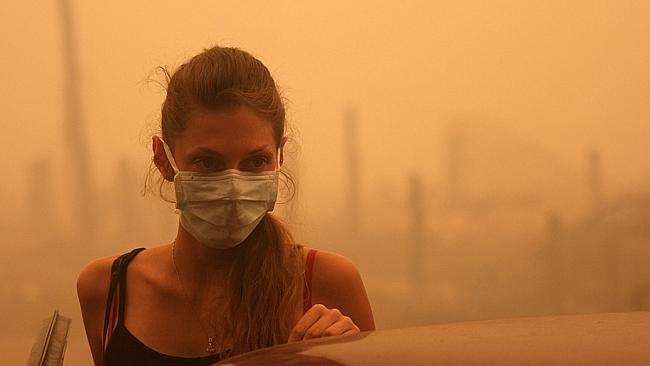Climate change tipping point revealed by study published in Nature
THE dreaded climate-change "tipping point", when changes to weather patterns will become irreversible, has been identified. And it is terrifying.
technology/environment
Don't miss out on the headlines from technology/environment. Followed categories will be added to My News.
THE dreaded climate-change "tipping point", when changes to weather patterns will become irreversible, has been identified. And it is terrifying.
Starting in about a decade, Kingston, Jamaica, will probably be off-the-charts hot - permanently. Other places will soon follow. Singapore in 2028. Mexico City in 2031. Cairo in 2036. Phoenix and Honolulu in 2043.
Australia will not be far behind, with dates ranging from 2038 in Sydney to 2049 in Adelaide.
Virtually the whole world will have changed by 2050.
A new study on global warming, published in the journal Nature, pinpoints the probable dates for when cities and ecosystems around the world will regularly experience hotter environments the likes of which they have never seen before.
For dozens of cities, mostly in the tropics, those dates are a generation or less away.

"This paper is both innovative and sobering," said Oregon State University professor Jane Lubchenco, former head of the National Oceanic and Atmospheric Administration, who was not involved in the study.
To arrive at their projections, the researchers used weather observations, computer models and other data to calculate the point at which every year from then on will be warmer than the hottest year ever recorded over the past 150 years.
39C - Sydney to cook as October record melts
37C - Brisbane in for another baking
For example, the world as a whole had its hottest year on record in 2005. The new study says that by the year 2047, every year that follows will probably be hotter than that record-setting scorcher.
Eventually, the coldest year in a particular city or region will be hotter than the hottest year in its past.
Study author Camilo Mora and his colleagues said they hope this new way of looking at climate change will spur governments to do something before it is too late.
"Now is the time to act," said another study co-author, Ryan Longman.
Mora, a biological geographer at the University of Hawaii, and colleagues ran simulations from 39 different computer models and looked at hundreds of thousands of species, maps and data points to ask when places will have "an environment like we had never seen before."
A date of 2047 for whole-world change (although a handful of cities are outside that range) is based on continually increasing emissions of greenhouse gases from the burning of coal, oil and natural gases. If the world manages to reduce its emissions of carbon dioxide and other gases, that would be pushed to as late as 2069, according to Mora.
But for now, Mora said, the world is rushing toward the 2047 date.
"One can think of this year as a kind of threshold into a hot new world from which one never goes back," said Carnegie Institution climate scientist Chris Field, who was not part of the study. "This is really dramatic."
Mora forecasts that the unprecedented heat starts in 2020 with Manokwa, Indonesia. Then Kingston, Jamaica. Within the next two decades, 59 cities will be living in what is essentially a new climate, including Singapore, Havana, Kuala Lumpur and Mexico City.
By 2043, 147 cities - more than half of those studied - will have shifted to a higher temperature regime that is beyond historical records.
The first US cities to feel that would be Honolulu and Phoenix, followed by San Diego and Orlando, Florida, in 2046. New York and Washington will get new climates around 2047, with Los Angeles, Detroit, Houston, Chicago, Seattle, Austin and Dallas a bit later.
Mora calculated that the last of the 265 cities to move into their new climate will be Anchorage, Alaska - in 2071. There's a five-year margin of error on the estimates.

Unlike previous research, the study highlights the tropics more than the polar regions. In the tropics, temperatures don't vary much, so a small increase can have large effects on ecosystems, he said. A 3C change is not much to polar regions but is dramatic in the tropics, which hold most of the Earth's biodiversity, he said.
The Mora team found that by one measurement - ocean acidity - Earth has already crossed the threshold into an entirely new regime. That happened in about 2008, with every year since then more acidic than the old record, according to study co-author Abby Frazier.
Of the species studied, coral reefs will be the first stuck in a new climate - around 2030 - and are most vulnerable to climate change, Mora said.
Pennsylvania State University climate scientist Michael Mann said the research "may be actually presenting an overly rosy scenario when it comes to how close we are to passing the threshold for dangerous climate impacts."
"By some measures, we are already there," he said.
THE TIPPING POINTS
Melbourne 2045
Sydney 2038
Perth 2042
Adelaide 2049
Manokwari (West Papua) 2020
Ngerulmud (Palau) 2023
Port-au-Prince 2025
Jakarta 2029
Durban 2035
Cairo 2036
Tokyo 2041
Beijing 2046
New York 2047
Los Angeles 2048
Toronto 2049
Paris 2054
Brussels 2056
London 2056
Moscow 2063
Anchorage 2071


